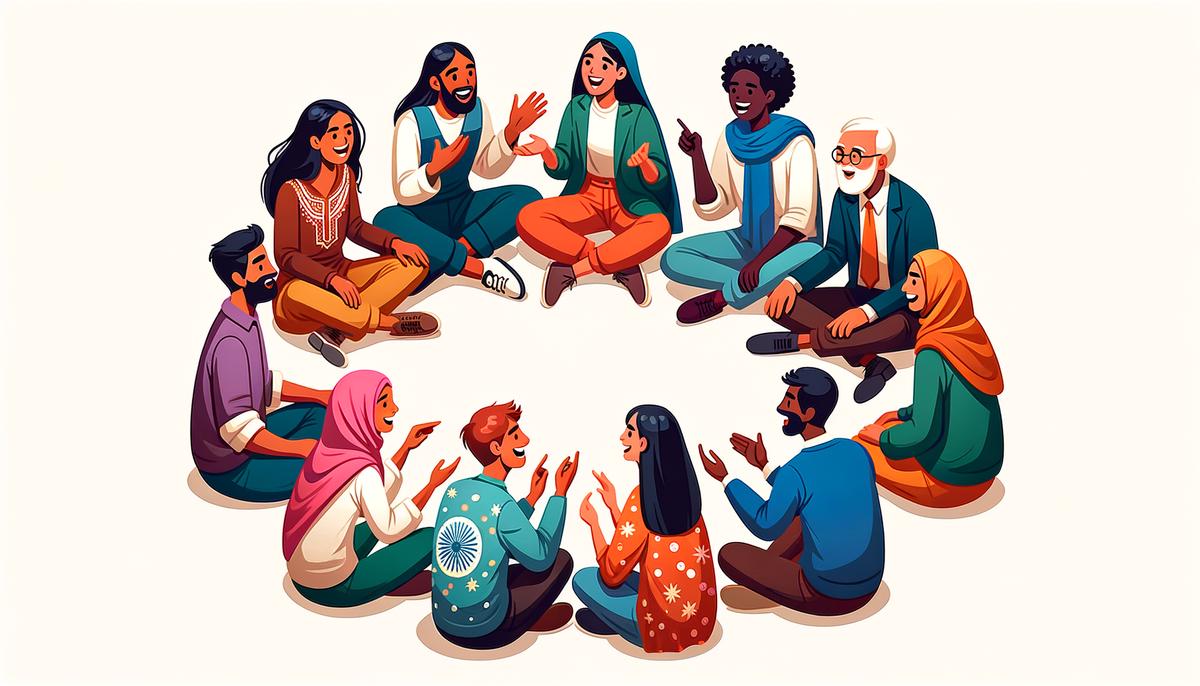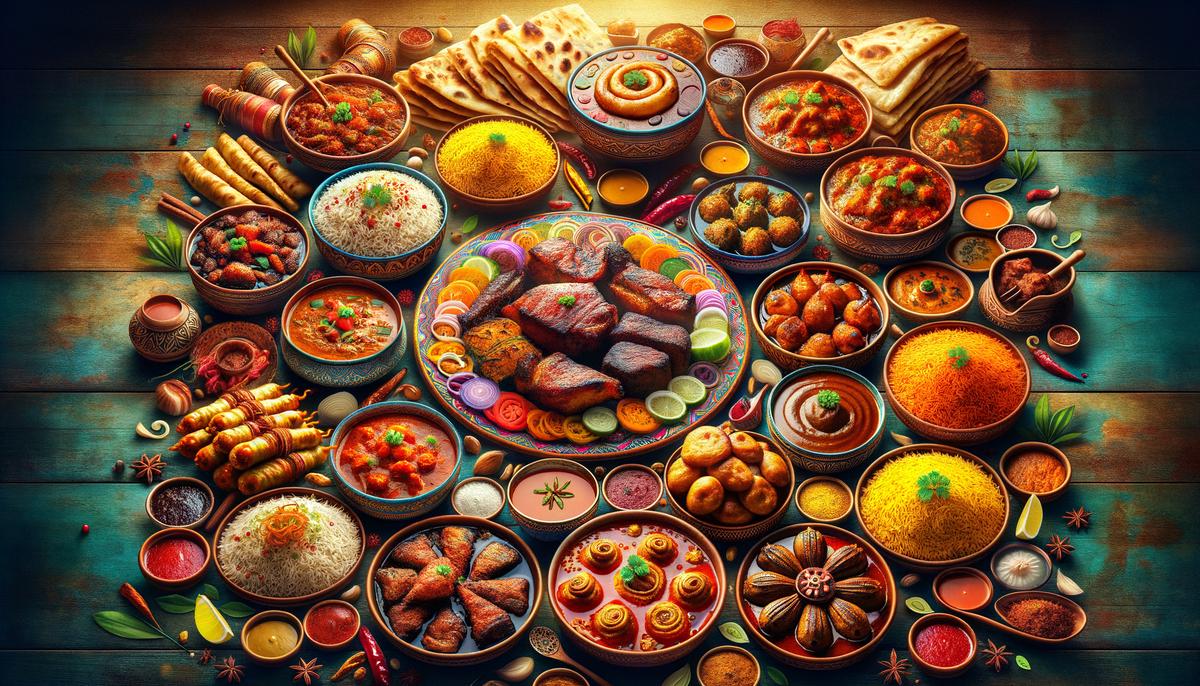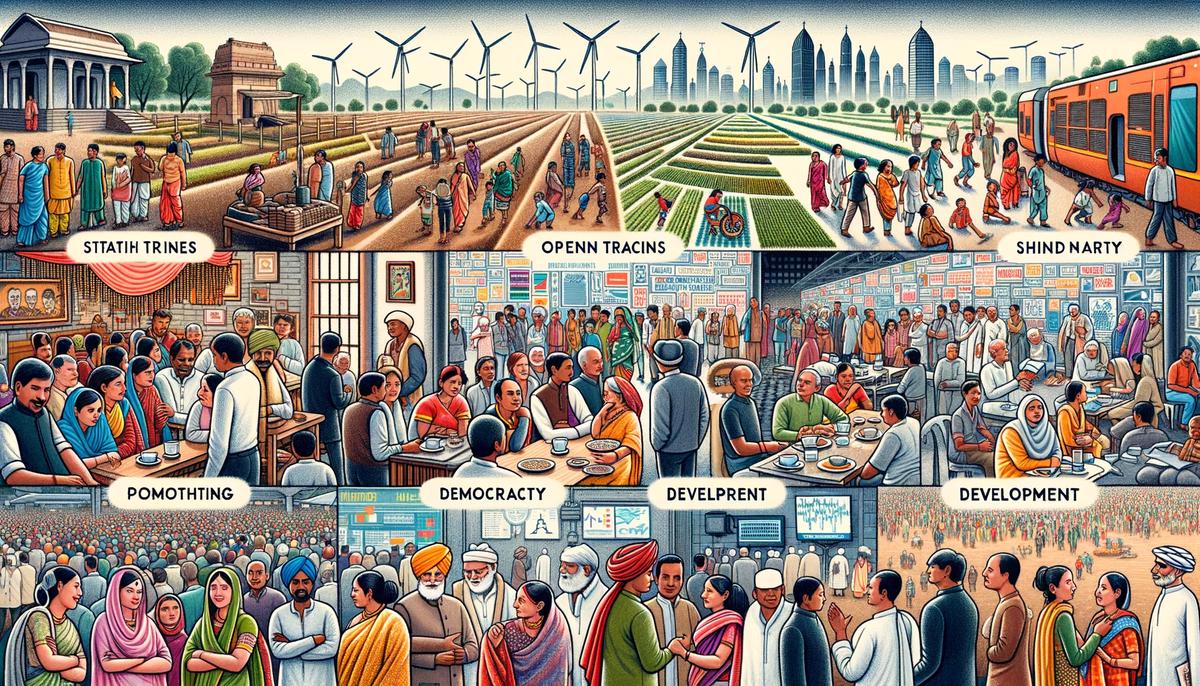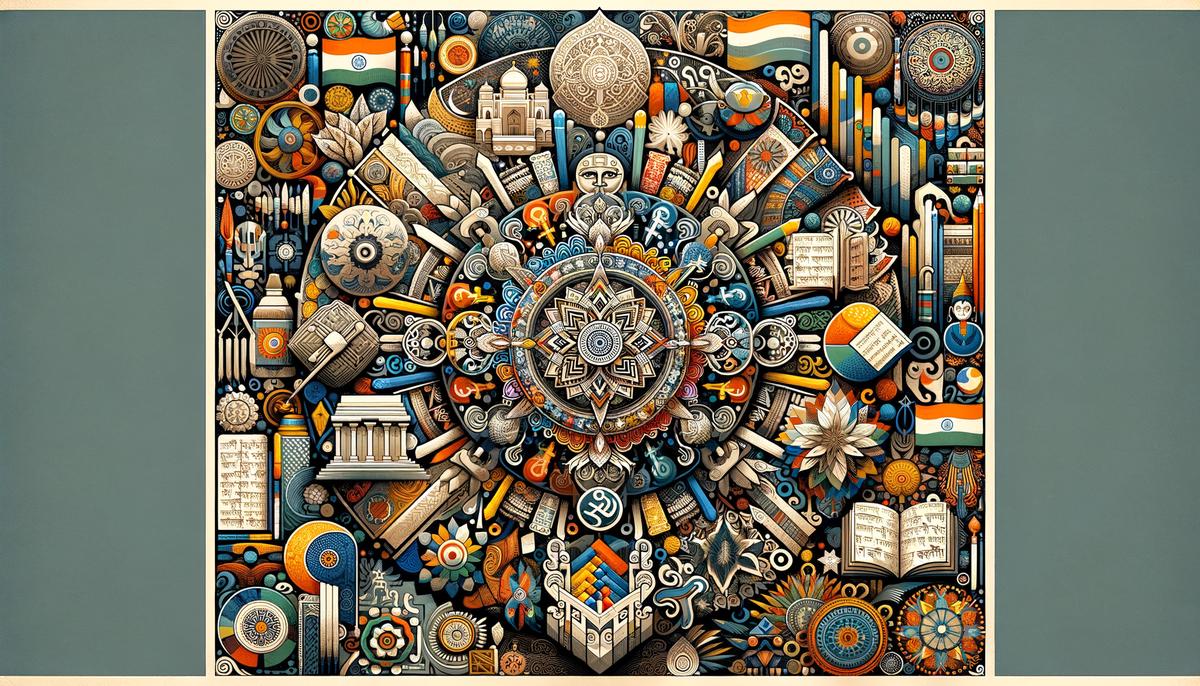Exploring the vast landscape of Indian culture feels like embarking on an exciting adventure into a world brimming with color, tradition, and history. From the ancient tunes played on the banks of the Indus River to the modern-day hustle and bustle of Mumbai’s streets, India’s culture weaves a story of diversity, creativity, and resilience. As we dive into the depths of India’s past, traverse its diverse landscapes, and savor the flavors of its rich cuisine, we also catch a glimpse of the vibrancy that defines contemporary Indian society and politics. Along this journey, the timeless art and literature of India serve as our guides, revealing the soul of this magnificent country and showcasing how tradition and innovation coexist harmoniously in the Indian spirit.
History and Evolution of Indian Culture
Exploring the Evolution of Indian Culture Through the Centuries
Diving into the rich tapestry of Indian culture reveals a dynamic, ever-evolving story. This journey takes us from ancient civilizations to the bustling India of today. Indian culture, known for its vibrant diversity and profound depth, has withstood the test of time, adapting and growing through each era. Let’s unwrap the layers of history to understand how Indian culture has shaped and been shaped over the centuries.
The Roots of Indian Civilization
The story begins with the Indus Valley Civilization, around 2500 BCE, which laid the initial cultural foundations. Known for its advanced urban planning and sophisticated craftsmanship, this era hinted at the early appreciation of art and community living in Indian culture. Fast forward to the Vedic Period, where the writing of the Vedas marked a significant evolution in religious and philosophical thought. These texts are not just religious scripts but also contain insights into the social, political, and scientific understanding of the time.
The Maurya and Gupta Empires: A Cultural Renaissance
As we move into the era of the Maurya and Gupta Empires, we see a flourishing of arts, sciences, and literature. The reign of Ashoka the Great during the Maurya Empire saw the spread of Buddhism, influencing not just religious beliefs but also art and architecture. The Gupta period, often referred to as the “Golden Age” of Indian culture, was a renaissance period where science, drama, poetry, and Hindu thought saw significant advancements.
The Mughal Influence and Regional Kingdoms
The arrival of the Mughals marked yet another pivotal chapter. The Mughal era was characterized by grandiose architecture, like the Taj Mahal, and a blending of Hindu and Muslim influences, creating a unique tapestry of culture and art. Meanwhile, the rise of regional kingdoms across India saw the flourishing of distinct languages, cuisines, and artistic traditions, further enriching the cultural landscape.
Colonial Period to Independence
The British colonial period introduced new elements to Indian culture, from the English language to the railways. Yet, it also spurred a resurgence of nationalistic pride and a renaissance in arts and literature as a means of asserting Indian identity. The struggle for independence was not just a political movement but also a cultural one, aiming to reclaim and celebrate Indian heritage.
Modern Times: A Global Melting Pot
In the contemporary era, Indian culture has embraced globalization while striving to preserve its rich heritage. Bollywood, India’s film industry, is a testament to how traditional narratives can adapt to modern mediums, enchanting audiences worldwide. The IT boom and the rise of cities have brought new challenges and opportunities, creating a blend of the traditional and the modern that defines India today.
The essence of Indian culture lies in its ability to evolve. From ancient times to the present day, it has absorbed influences, overcome challenges, and celebrated its diversity. This journey reflects not just the resilience but also the vibrant, dynamic spirit of India that continues to captivate and inspire across time.
Engaging with the plethora of traditions, languages, and practices that constitute Indian culture offers an endless well of understanding and appreciation. Each epoch, from the ancient civilizations through the ages of empires and on to the modern day, contributes to the intricate mosaic that Indian culture represents, a breathtaking fusion of the old and the new, constantly evolving yet deeply rooted in its ancient traditions.

Diversity in India
Exploring the Diversity of Languages and Dialects
India’s linguistic landscape is a mosaic of diversity, with over 22 officially recognized languages across the country and hundreds of dialects. This linguistic multiplicity not only adds to the cultural richness but also reflects the country’s complex history of migrations and conquests. Each language carries with it a heritage of literature, folklore, and music, contributing to India’s intangible cultural wealth. From the poetic cadences of Tamil in the south to the lyrical rhythms of Punjabi in the north, languages in India are not just modes of communication but are deeply intertwined with cultural identities.
Religious Pluralism: A Testament to Tolerance
India’s religious tapestry is vibrant and varied, encompassing a wide range of beliefs and practices. Hinduism, Buddhism, Jainism, and Sikhism originated here, while Islam, Christianity, Judaism, and others have been absorbed, each leaving a significant imprint on the societal structure. This pluralism is visible in the myriad of festivals celebrated, the architectural marvels of temples, mosques, churches, and gurdwaras dotting the landscape, and the philosophical discourses that have evolved in the Indian subcontinent over millennia. The peaceful coexistence of these diverse religious practices underlines a historical legacy of tolerance and mutual respect.
Culinary Diversity: A Feast for the Senses
Indian cuisine, with its plethora of flavors and ingredients, is a testament to the country’s diversity. Each region offers its own unique dishes, influenced by geography, climate, and history. From the spicy curries of the south to the tandoori dishes of the north, Indian cuisine is a kaleidoscope of tastes and traditions. Spices play a central role, not just for flavoring but also for their health benefits, a knowledge passed down through generations. Eating in India is not just about sustenance; it’s a cultural experience, a celebration of diversity and unity on a plate.
Crafts and Artisanal Heritage: Weaving Diversity Together
India’s artisanal and craft traditions are as varied as its people. Each state, each district, can boast of its unique handicrafts – be it the intricate weavings of Banarasi sarees, the detailed craftsmanship of Kutch embroidery, or the centuries-old traditions of Channapatna toys. These crafts are not just items of utility or decor but carry within them stories, traditions, and the very essence of the place they originate from. Governments and NGOs are working towards preserving these precious skills, recognizing their importance in the cultural tapestry of India.
India’s Environmental Diversity: From Snow-capped Peaks to Tropical Beaches
The geographical diversity of India is staggering. It is a land where the snow-capped Himalayas stand guard in the north, the Thar Desert stretches out in the west, tropical rainforests thrive in the northeast, and pristine beaches grace the southern coasts. This variety in geography and climate supports a rich biodiversity, including an array of flora and fauna. National parks and wildlife sanctuaries across the country protect many endangered species, such as the Royal Bengal Tiger, the Asiatic Lion, and the Indian Elephant, emphasizing India’s commitment to conservation.
The Spirit of Unity in Diversity
What truly makes India a land of unparalleled diversity is the underlying unity among its people. Despite the differences, there is a shared sense of belonging, a common thread of humanity that weaves through the fabric of Indian society. Festivals, traditions, and everyday practices often see a blending of cultural influences, creating a unique syncretic culture that is inclusive and embracing. It’s this sense of unity in diversity that stands as a testament to India’s enduring ethos and resilience, making it not just a country, but a civilization to reckon with. Through its diversity, India demonstrates to the world the strength found in differences and the beauty of coming together.

Indian Cuisine
Building on the rich tapestry of India’s past and its vibrant present, the question arises: why is Indian cuisine hailed as one of the most diverse globally? Delving into this culinary mosaic, we find a blend of historical influences, geographic variations, and cultural integrations that together paint the picture of Indian cuisine’s diversity.
India’s culinary diversity is deeply rooted in its historical invasions and trade interactions. Each wave of conquerors and traders brought with them new spices, cooking methods, and food philosophies. From the Arab traders introducing the use of dried fruits and nuts in dishes, to the Portuguese bringing the chili pepper from the New World, each influence seamlessly wove into the fabric of Indian cuisine, creating a rich tapestry of flavors.
Geographical diversity plays a pivotal role in shaping the multitude of Indian cuisines. From the coastal regions benefiting from an abundance of seafood and coconut, to the fertile plains of the Ganges nurturing an extensive variety of grains and vegetables, each region has developed its distinct culinary practices. In the arid lands of Rajasthan, for instance, the scarcity of water and fresh green vegetables has given rise to a cuisine that relies heavily on dried lentils, beans, and dairy for sustenance, showcasing an innovative use of local resources.
Cultural and religious practices in India also significantly influence its cuisine. The diverse religious beliefs across the country have led to a wide range of dietary practices and food traditions. Vegetarianism, deeply rooted in Hindu and Jain philosophies, has inspired a vast assortment of vegetarian dishes that are both nutritious and flavorful. Meanwhile, the Muslim influence is evident in the rich, meat-heavy dishes of Mughlai cuisine, famous for its Biryanis and Kebabs.
Another intriguing aspect is the tradition of Ayurveda in Indian culinary practices. Ayurveda, the ancient Indian science of life and longevity, emphasizes the importance of balancing flavors and nutrition in meals. This has led to the use of a wide array of spices not just for their flavor, but for their health benefits. Turmeric, cumin, ginger, and fenugreek are just a few examples of the spices that make Indian food not only delicious but also traditionally considered as healing.
The culinary diversity of India is further enriched by the celebration of festivals, where special dishes are prepared that reflect the cultural and spiritual significance of each occasion. From the sweet delights of Diwali to the savory treats of Eid, these festival foods are a testament to India’s multifaceted culinary identity.
Indian cuisine’s ability to adapt and evolve continually is another hallmark of its diversity. The globalization era has seen Indian chefs both at home and abroad innovating and experimenting, blending traditional dishes with global influences, thus continuously expanding the boundaries of Indian cuisine.
In essence, Indian cuisine mirrors the country’s ethos of unity in diversity. It’s a splendid amalgamation of flavors, textures, and aromas that not only tantalizes the palate but also tells the story of India’s rich history, diverse cultures, and vibrant traditions. Each dish, from the simplest dal to the most intricate biryani, carries with it centuries of history, a medley of influences, and the warmth of Indian hospitality, making Indian cuisine one of the most fascinating and diverse culinary traditions in the world.

Contemporary Indian Society and Politics
Navigating the Complex Landscape: How Socio-Political Dynamics Shape India Today
India, with its kaleidoscopic variety and depth, is not just a country but a continent within itself—marked by a rich tapestry of socio-political dynamics that continuously shapes its present and future. As we delve into the nuances of India’s current socio-political landscape, we uncover a story of evolution, challenges, and resilience that not only defines its identity but also its path forward in an ever-changing global arena.
The Mosaic of Politics in Indian Democracy
At the heart of India’s socio-political realm is the world’s largest democracy, vibrant and boisterous, framed by a multitude of political parties representing the spectrum of its diverse populace. From national giants like the Bharatiya Janata Party (BJP) and the Indian National Congress to regional powerhouses such as the All India Trinamool Congress and the Dravida Munnetra Kazhagam, the political landscape is as varied as it is dynamic. This multiplicity in political representation ensures that the voices from the snow-capped peaks of Kashmir to the tropical coasts of Kerala find a place in the parliamentary discourse, influencing policies that range from economic reforms to social welfare.
The Ripple Effects of Economic Policies
India’s economy, one of the fastest-growing in the world, is a testament to its robust socio-political foundation, which has navigated through liberalization in the 1990s to embrace globalization. Economic policies, shaped by both internal and external political pressures, have a direct impact on everyday life, from the bustling stock markets of Mumbai to the rural farms in Punjab. Initiatives like “Make in India” aim to bolster manufacturing and transform India into a global design and manufacturing hub, affecting job creation and economic inclusivity. However, challenges remain, including income inequality and regional disparities, which continue to be hot-button issues in political and social dialogues.
The Digital Revolution and Social Change
India’s socio-political scene is also being profoundly reshaped by the digital revolution, ushering in an era of social media that enables instant communication and mobilization. Platforms like Twitter, Facebook, and WhatsApp have become arenas for political campaigns, public opinions, and movements, allowing for greater participation and engagement across society. This digital democratization is creating spaces for previously unheard voices, offering a medium for social change and activism, from gender rights to environmental conservation. Yet, it also presents challenges, including misinformation and digital divide, reflecting the complexities of India’s march towards technological empowerment.
Social Harmony Amidst Diversity
The cornerstone of India’s socio-political fabric is its commitment to secularism and social harmony, underpinned by constitutional protections. Despite the country’s mosaic of religions, languages, and cultures, there exists a concerted effort towards maintaining communal harmony and ensuring that the secular ethos of the country is preserved. This is not without its tests, as incidents of communal tensions and debates over citizenship laws have shown, revealing the delicate balance required to navigate the diversity. It is the spirit of unity in diversity, deeply ingrained in the Indian psyche, that often triumphs, reinforcing the resilience of India’s social tapestry.
Environmental Politics: A Growing Concern
The impact of climate change and environmental degradation has brought environmental politics to the forefront of India’s socio-political discourse. With initiatives like the International Solar Alliance and commitments at global climate summits, India is taking significant steps towards a sustainable future. However, the environmental agenda is also fraught with debates over development versus conservation, illustrating the intricate dance between economic growth and environmental stewardship in shaping policies.
In conclusion, the socio-political dynamics of India today are a complex web of democracy, diversity, and development. They are shaped by a history that celebrates pluralism, faced with contemporary challenges that demand innovative solutions. It’s a narrative of a nation at the cusp of global influence, navigating the currents of change with an eye on preserving its rich heritage and ethos. As India continues to evolve, its socio-political landscape will undoubtedly play a pivotal role in determining its trajectory on the world stage, making it an exciting, if unpredictable, journey into the future.

Indian Art and Literature
Art and literature are not just forms of expression in Indian society; they are the threads that weave the complex fabric of its culture, history, and identity. These mediums have been pivotal in narrating India’s past, shaping its present, and dreaming of its future. Let’s dive into the intertwined world of Indian art and literature to uncover their roles in this vibrant society.
At the heart of Indian literature lies the power of storytelling, with roots extending back to the ancient epics of the Mahabharata and the Ramayana. These texts are more than just stories; they are moral and philosophical guides that have shaped the cultural and ethical landscape of India for centuries. Literature in India has evolved over time, embracing different languages, dialects, and themes, reflecting the country’s vast diversity. From the romantic poetry of the Bhakti movement to the poignant narratives of the Partition, Indian literature has captured the essence of every era.
Modern Indian literature continues this legacy, addressing contemporary issues such as social inequality, political unrest, and the challenges of globalization. It serves as a mirror reflecting the joys, sorrows, struggles, and aspirations of the Indian people, thereby strengthening societal bonds. Writers like Rabindranath Tagore, R.K. Narayan, and Arundhati Roy, with their diverse narratives, have brought Indian literature to the global stage, offering insights into the intricacies of Indian life.
Parallel to literature, art in India paints its own tapestry of cultural identity. Indian art, with its vivid colors, intricate patterns, and profound symbolism, serves as a visual narrative of the country’s history. From the ancient cave paintings of Bhimbetka to the classical sculptures of the Chola dynasty, each artefact tells a story of spiritual beliefs, social structures, and political power.
Contemporary Indian art, much like its literary counterpart, is a vibrant amalgamation of traditional techniques and modern themes. It challenges societal norms, questions political decisions, and reflects the rapid changes sweeping through the country. Artists like M.F. Husain, S.H. Raza, and Amrita Sher-Gil have played pivotal roles in placing Indian art on the international map, showcasing the country’s rich cultural heritage and its dynamic present.
Moreover, art and literature in India perform a crucial role in education and awareness. They are tools for social change, empowering communities to voice their concerns and aspire for a better future. Festivals, exhibitions, and literary meets across the country provide platforms for dialogue and interaction, fostering a sense of unity in diversity.
In essence, art and literature are the soul of Indian society. They encapsulate the country’s rich past, vibrant present, and hopeful future. Through their myriad forms, they teach, inspire, and unite, playing an indispensable role in the continual shaping of India’s identity. Whether it is through the lyrical verses of a poem or the bold strokes of a painting, art and literature in India will continue to be the bearers of its cultural legacy, resonating with the ethos of an ancient, yet ever-evolving society.

As we wrap up our exploration of India’s cultural panorama, it’s clear that India’s story is far from a simple tale. It’s a vibrant mosaic, rich with diversity, history, and innovation. The flavors of its cuisine, the diversity of its people, the vibrancy of its arts, and the dynamism of its society and politics all paint a picture of a nation that, despite its challenges, stands resilient and proud. The essence of India lies in its ability to embrace its past while boldly marching towards the future—making it a land of endless discovery and inspiration for both its citizens and the global community. Let this journey through India’s culture remind us of the beauty that lies in diversity and the strength we find in unity.

Leave a Reply